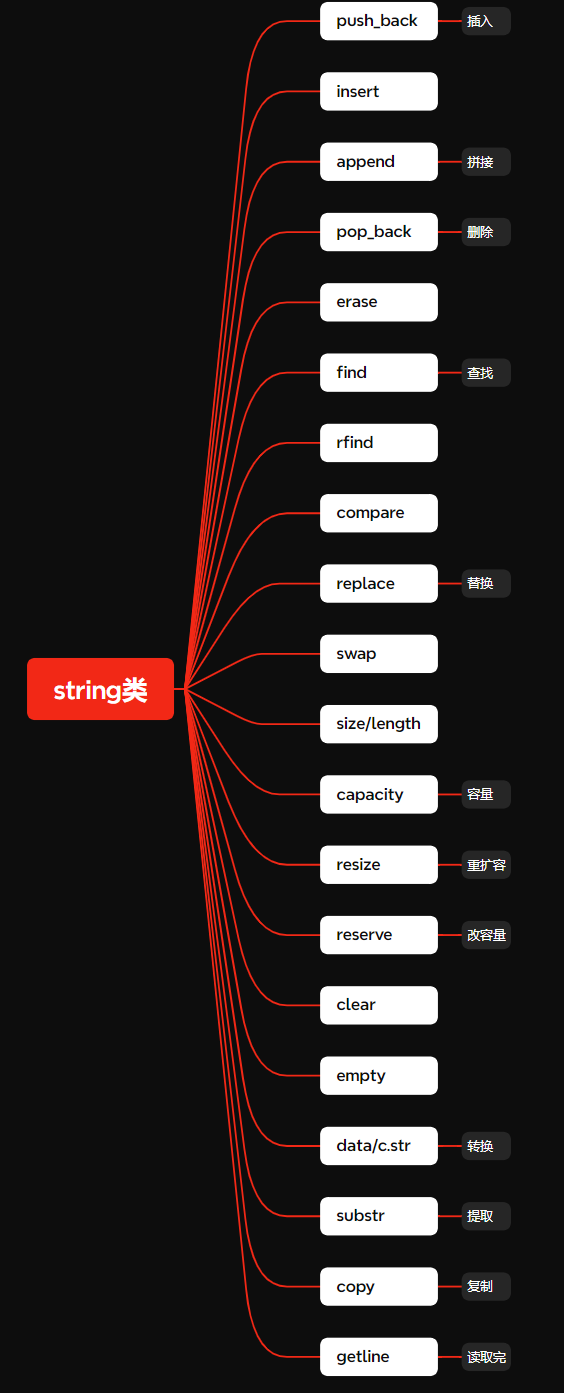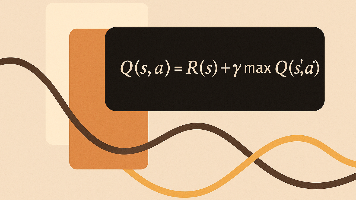string类(一)
思维导图

一、string的定义方式
string类实现了多个构造函数的重载,常用的构造函数如下:
string(); //构造一个空字符串
string(const char* s); //复制s所指的字符序列
string(const char* s, size_t n); //复制s所指字符序列的前n个字符
string(size_t n, char c); //生成n个c字符的字符串
string(const string& str); //生成str的复制品
string(const string& str, size_t pos, size_t len = npos); //复制str中从字符位置pos开始并跨越len个字符的部分
使用示例:
string s1; //构造空字符串
string s2("hello string"); //复制"hello string"
string s3("hello string", 3); //复制"hello string"的前3个字符
string s4(10, 's'); //生成10个's'字符的字符串
string s5(s2); //生成s2的复制品
string s6(s2, 0, 4); //复制s2中从字符位置0开始并跨越4个字符的部分
二、string的插入
1、使用push_back进行尾插
void push_back (char c);
#include <iostream>
#include <string>
using namespace std;
int main()
{
string s;
s.push_back('C');
s.push_back('S');
s.push_back('D');
s.push_back('N');
cout << s << endl; //CSDN
return 0;
}
2、使用insert插入
string& insert (size_t pos, const string& str); // 第一个参数:在第几个位置插入
string& insert (size_t pos, const char* s);
iterator insert (iterator p, char c); //迭代器
#include <iostream>
#include <string>
using namespace std;
int main()
{
string s("C"); //C
//insert(pos, str)在pos位置插入字符串str
s.insert(1, "S"); //CS
//insert(pos, string)在pos位置插入string对象
string t("D");
s.insert(2, t); //CSD
//insert(pos, char)在pos位置插入字符char
s.insert(s.end(), 'N'); //CSDN
cout << s << endl; //CSDN
return 0;
}
三、string的拼接
使用append函数完成string的拼接:
#include <iostream>
#include <string>
using namespace std;
int main()
{
string s1("I");
string s2(" like");
//append(string)完成两个string对象的拼接
s1.append(s2); //I like
//append(str)完成string对象和字符串str的拼接
s1.append(" C++"); //I like C++
//append(n, char)将n个字符char拼接到string对象后面
s1.append(3, '!'); //I like C++!!!
cout << s1 << endl; //I like C++!!!
return 0;
}
四、string的删除
1、使用pop_back进行尾删
void pop_back();
#include <iostream>
#include <string>
using namespace std;
int main()
{
string s("C++");
s.pop_back();
s.pop_back();
cout << s << endl; //C
return 0;
}
2、使用erase删除
string& erase (size_t pos = 0, size_t len = npos); //左边:哪个位置开始
iterator erase (iterator p);
iterator erase (iterator first, iterator last);
#include <iostream>
#include <string>
using namespace std;
int main()
{
string s("I like C++!!!");
//erase(pos, n)删除pos位置开始的n个字符
s.erase(8, 5); //I like C
//erase(pos)删除pos位置的字符
s.erase(s.end()-1); //I like 注意必须是迭代器
//erase(pos1, pos2)删除[pos1pos2)上所有字符
s.erase(s.begin() + 1, s.end()); //I 迭代器
cout << s << endl; //I
return 0;
}
五、string的查找
1、使用find函数正向搜索第一个匹配项
size_t find (const string& str, size_t pos = 0) const; //返回类型是size_t,返回找到的第一个坐标
size_t find (const char* s, size_t pos = 0) const;
size_t find (char c, size_t pos = 0) const;
#include <iostream>
#include <string>
using namespace std;
int main()
{
string s1("http://www.cplusplus.com/reference/string/string/find/");
//find(string)
string s2("www");
size_t pos1 = s1.find(s2); //在s1中找s2
cout << pos1 << endl; //7
//find(str)
char str[] = "cplusplus.com";
size_t pos2 = s1.find(str);
cout << pos2 << endl; //11
//find(char)
size_t pos3 = s1.find(':');
cout << pos3 << endl; //4
return 0;
}
2、使用rfind函数反向搜索第一个匹配项
size_t rfind (const string& str, size_t pos = npos) const; // 返回类型时size_t
size_t rfind (const char* s, size_t pos = npos) const;
size_t rfind (char c, size_t pos = npos) const;
#include <iostream>
#include <string>
using namespace std;
int main()
{
string s1("http://www.cplusplus.com/reference/string/string/find/");
string s2("string");
size_t pos1 = s1.rfind(s2);
cout << pos1 << endl; //42
char str[] = "reference";
size_t pos2 = s1.rfind(str);
cout << pos2 << endl; //25
size_t pos3 = s1.rfind('/');
cout << pos3 << endl; //53
return 0;
}
六、string的比较
使用compare函数完成比较:
int compare (const string& str) const;
int compare (size_t pos, size_t len, const string& str) const;
int compare (size_t pos, size_t len, const string& str, size_t subpos, size_t sublen) const;
比较规则:
1、比较字符串中第一个不匹配的字符值较小,或者所有比较字符都匹配但比较字符串较短,则返回小于0的值。
2、比较字符串中第一个不匹配的字符值较大,或者所有比较字符都匹配但比较字符串较长,则返回大于0的值。
3、比较的两个字符串相等,则返回0。
#include <iostream>
#include <string>
using namespace std;
int main()
{
string s1("hello world");
string s2("hello CSDN");
//"hello world"和"hello CSDN"比较
cout << s1.compare(s2) << endl; //1
//"ell"和"hello CSDN"比较
cout << s1.compare(1, 3, s2) << endl; //-1
//"hello"和"hello"比较
cout << s1.compare(0, 4, s2, 0, 4) << endl; //0
return 0;
}
注意:除了支持string类之间进行比较,compare函数还支持string类和字符串进行比较。
七、string的替换
使用replace函数完成string的替换:
string& replace (size_t pos, size_t len, const char* s);
string& replace (size_t pos, size_t len, size_t n, char c);
#include <iostream>
#include <string>
using namespace std;
int main()
{
string s("hello world");
//replace(pos, len, str)将pos位置开始的len个字符替换为字符串str
s.replace(6, 4, "CSDN"); //hello CSDNd
//replace(pos, len, n, char)将pos位置开始的len个字符替换为n个字符char
s.replace(10, 1, 3, '!'); //hello CSDN!!!
cout << s << endl;
return 0;
}
八、string的交换
使用swap函数完成两个string类的交换:
void swap (string& x, string& y);
void swap (string& str);
#include <iostream>
#include <string>
using namespace std;
int main()
{
string s1("hello");
string s2("CSDN");
//s1和s2交换
s1.swap(s2);
//另一种办法,s1和s2交换
swap(s1, s2);
return 0;
}
九、string的大小和容量
1、使用size函数或length函数获取当前有效字符的个数
size_t size() const; //返回值是size_t
size_t length() const;
#include <iostream>
#include <string>
using namespace std;
int main()
{
string s("CSDN");
cout << s.size() << endl; //4
cout << s.length() << endl; //4
return 0;
}
2、max_size函数返回该字符串对象在系统上可能达到的最大长度
size_t max_size() const;
#include <iostream>
#include <string>
using namespace std;
int main()
{
string s("CSDN");
cout << s.max_size() << endl; //4294967294
return 0;
}
3、capacity 返回字符串当前分配的内存空间能容纳的最大字符数(不包括结尾的空终止符 \0)。
它表示在不触发内存重新分配的情况下,字符串还能追加多少字符。
size_t capacity() const;
string s("CSDN");
cout << s.capacity() << endl; //154、resize就是重新扩容
void resize (size_t n);
void resize (size_t n, char c);
resize规则:
1、当n大于对象当前的size时,将size扩大到n,扩大的字符为c,若c未给出,则默认为’\0’。
2、当n小于对象当前的size时,将size缩小到n。
#include <iostream>
#include <string>
using namespace std;
int main()
{
string s2("CSDN"); //大于
s2.resize(20, 'x'); //CSDNxxxxxxxxxxxxxxxx
string s3("CSDN"); //小于
s3.resize(2); //CS
return 0;
}
注意:若给出的n大于对象当前的capacity,则capacity也会根据自己的增长规则进行扩大。
5、使用reserve改变当前对象的容量大小
void reserve (size_t n = 0);
reserve规则:
1、当n大于对象当前的capacity时,将capacity扩大到n或大于n。
2、当n小于对象当前的capacity时,什么也不做。
#include <iostream>
#include <string>
using namespace std;
int main()
{
string s("CSDN");
cout << s.capacity() << endl; //15
//reverse(n)当n大于对象当前的capacity时,将当前对象的capacity扩大为n或大于n
s.reserve(50);
cout << s.capacity() << endl; //63
//reverse(n)当n小于对象当前的capacity时,什么也不做
s.reserve(20);
cout << s.capacity() << endl; //63
return 0;
}
6、使用clear删除对象的内容,删除后对象变为空字符串
void clear();
s.clear();7、使用empty判断对象是否为空
bool empty() const;
string s("CSDN");
cout << s.empty() << endl; //不空返回0
s.clear();
cout << s.empty() << endl; //空返回1
十、string中元素的访问
1、[ ]+下标
因为string类对[ ]运算符进行了重载,所以我们可以直接使用[ ]+下标访问对象中的元素。并且该重载使用的是引用返回,所以我们可以通过[ ]+下标修改对应位置的元素。
char& operator[] (size_t pos);
const char& operator[] (size_t pos) const;
#include <iostream>
#include <string>
using namespace std;
int main()
{
string s("CSDN");
//[]+下标访问对象元素
for (size_t i = 0; i < s.size(); i++)
{
cout << s[i]; //CSDN
}
cout << endl;
//[]+下标修改对象元素内容
for (size_t i = 0; i < s.size(); i++)
{
s[i] = 'x';
}
cout << s << endl; //xxxx
return 0;
}
2、使用at访问对象中的元素
因为at函数也是使用的引用返回,所以我们也可以通过at函数修改对应位置的元素。
char& at (size_t pos);
const char& at (size_t pos) const;
#include <iostream>
#include <string>
using namespace std;
int main()
{
string s("CSDN");
for (size_t i = 0; i < s.size(); i++)
{
cout << s.at(i); //CSDN
}
cout << endl;
for (size_t i = 0; i < s.size(); i++)
{
s.at(i) = 'x';
}
cout << s << endl; //xxxx
return 0;
}
3、使用范围for访问对象中的元素
注意:通过范围for修改,接收变量e的类型必须是引用类型,否则e只是拷贝,不会影响到要修改的对象。
#include <iostream>
#include <string>
using namespace std;
int main()
{
string s("CSDN");
//未修改成功
for (auto e : s)
{
cout << e;
}
cout << endl; //CSDN
for (auto& e : s) //引用修改成功
{
e = 'x';
}
cout << s << endl; //xxxx
return 0;
}
4、使用迭代器访问对象中的元素
#include <iostream>
#include <string>
using namespace std;
int main()
{
string s("CSDN");
//访问
string::iterator it1 = s.begin();
while (it1 != s.end())
{
cout << *it1;
it1++;
}
cout << endl; //CSDN
//使用迭代器修改
string::iterator it2 = s.begin();
while (it2 != s.end())
{
*it2 += 1;
it2++;
}
cout << s << endl; //DTEO
return 0;
}
十一、string中运算符的使用
1、operator=
string类中对=运算符进行了重载,重载后的=运算符支持string类的赋值、字符串的赋值以及字符的赋值。
#include <iostream>
#include <string>
using namespace std;
int main()
{
string s1;
string s2("CSDN");
//支持string类的赋值
s1 = s2; //CSDN
//支持字符串的赋值
s1 = "hello"; //hello
//支持字符的赋值
s1 = 'x'; //x
return 0;
}
2、operator+=
string类中对+=运算符进行了重载,重载后的+=运算符支持string类、字符串、字符 的复合赋值。
#include <iostream>
#include <string>
using namespace std;
int main()
{
string s1;
string s2("hello");
//支持string类的复合赋值
s1 += s2; //hello
//支持字符串的复合赋值
s1 += " CSDN"; //hello CSDN
//支持字符的复合赋值
s1 += '!'; //hello CSDN!
return 0;
}
3、operator+
string类中对+运算符进行了重载,重载后的+运算符支持以下几种类型的操作:
string类 + string类
string类 + 字符串
字符串 + string类
string类 + 字符
字符 + string类
总之,一定要加上string类,它们相加后均返回一个string类对象。
string s1("super");
string s2("man");
//string类 + string类
s = s1 + s2;
cout << s << endl; //superman4、operator>> 和 operator<<
string类中也对>>和<<运算符进行了重载。
cin >> s;
cout << s;5、relational operators
string类中还对一系列关系运算符进行了重载,它们分别是==、!=、<、<=、>、>=。重载后的关系运算符支持string类和string类之间的关系比较、string类和字符串之间的关系比较、字符串和string类之间的关系比较(反正都带string)。
string s1("abcd");
string s2("abde");
cout << (s1 > s2) << endl; //0
cout << (s1 < s2) << endl; //1
cout << (s1 == s2) << endl; //0十二、string中与迭代器相关的函数
1、与正向迭代器相关的函数
begin函数:返回一个指向字符串第一个字符的迭代器。
end函数:返回一个指向字符串结束字符的迭代器,即’\0’。
使用示例:
#include <iostream>
#include <string>
using namespace std;
int main()
{
string s("hello string");
//正向迭代器
string::iterator it = s.begin();
while (it != s.end())
{
cout << *it;
it++;
}
cout << endl; //hello string
return 0;
}
十三、string与字符串之间的转换
1、将字符串转换为string
将字符串转换为string很简单,在前面讲string的定义方式时就有说到。
#include <iostream>
#include <string>
using namespace std;
int main()
{
//方式一
string s1("hello world");
//方式二
char str[] = "hello world";
string s2(str);
cout << s1 << endl; //hello world
cout << s2 << endl; //hello world
return 0;
}
2、使用c_str或data 将string转换为字符串
const char* c_str() const;
const char* data() const;
区别:
- 在C++98中,c_str()返回 const char* 类型,返回的字符串会以空字符结尾。
- 在C++98中,data()返回 const char* 类型,返回的字符串不以空字符结尾。
- 但是在C++11版本中,c_str()与data()用法相同。
#include <iostream>
#include <string>
using namespace std;
int main()
{
string s("hello world ");
const char* str1 = s.data(); //hello world
const char* str2 = s.c_str(); //hello world
return 0;
}
十四、string中子字符串的提取
1、使用substr函数提取string中的子字符串
string substr (size_t pos = 0, size_t len = npos) const;
#include <iostream>
#include <string>
using namespace std;
int main()
{
string s1("abcdef");
string s2;
//substr(pos, n)提取pos位置开始的n个字符序列作为返回值
s2 = s1.substr(2, 4);
cout << s2 << endl; //cdef
return 0;
}
2、使用copy函数将string的子字符串复制到字符数组中
size_t copy (char* s, size_t len, size_t pos = 0) const;
#include <iostream>
#include <string>
using namespace std;
int main()
{
string s("abcdef");
char str[20];
//copy(str, n, pos)复制pos位置开始的n个字符到str字符串
size_t length = s.copy(str, 4, 2);
//copy函数不会在复制内容的末尾附加'\0',需要手动加
str[length] = '\0';
cout << str << endl; //dcef
return 0;
}
十五、string中的getline函数
我们知道,使用>>进行输入操作时,当>>读取到空格便会停止读取,基于此,我们不能用>>将一串含有空格的字符串读入到string对象中。
这时,我们就需要用getline函数完成一串含有空格的字符串的读取操作了。
用法一:
istream& getline (istream& is, string& str);
getline函数将读取到换行符’\n’为止。
#include <iostream>
#include <string>
using namespace std;
int main()
{
string s;
getline(cin, s); //输入:hello CSDN
cout << s << endl; //输出:hello CSDN
return 0;
}

为武汉地区的开发者提供学习、交流和合作的平台。社区聚集了众多技术爱好者和专业人士,涵盖了多个领域,包括人工智能、大数据、云计算、区块链等。社区定期举办技术分享、培训和活动,为开发者提供更多的学习和交流机会。
更多推荐
 已为社区贡献1条内容
已为社区贡献1条内容








所有评论(0)